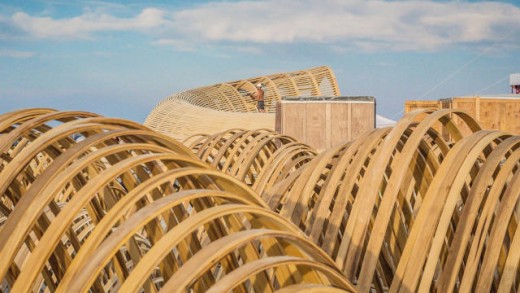The Burning Man Temple Project, LLC
This startup’s exit isn’t an IPO, it’s a pyre. A really big pyre.
Imagine walking into an investor meeting and saying, “I need funding for my $300,000 project—but oh, by the way, when we’re done with our startup, we’re going to burn our product to the ground.” Then imagine having the same conversations with banks and insurance brokers.
That’s what the crew behind the Temple of Promise have gone through over the last few months as they pursued their dream of building this year’s Burning Man temple.
Burning Man, of course, is the annual counterculture arts festival that begins Sunday in Nevada’s Black Rock Desert. At the center of the festival is its namesake, the Man, which will be burned next Saturday night. More than 70,000 participants are expected to attend the festival.
Each year since 2000, the second-most-visible piece on the playa (as the Black Rock Desert is known) has been the Temple. In most years, the Temple is built by artist David Best—but sometimes other groups take on the considerable responsibility of constructing the structure. A different design every year, the temple is meant to be a sacred space where tens of thousands of people gather during the festival to memorialize their lost loved ones and share their grief and deep emotions with others. While the burning of the Man is a joyous celebration, the burning of the Temple the following night is a much more somber release.
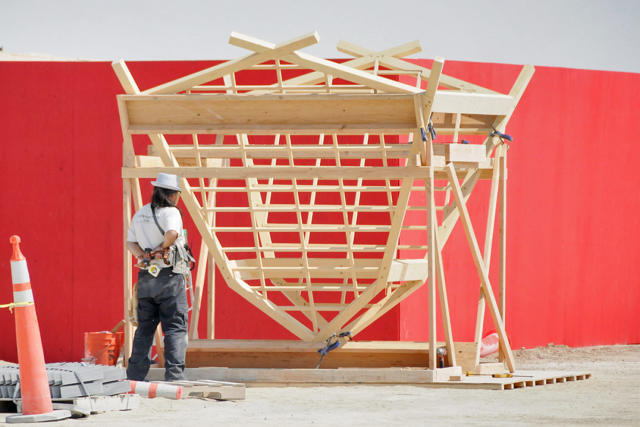
What many people—even veteran “burners,” as Burning Man attendees are known—may not realize is that while the Man is built by the Burning Man organization, the Temple is largely the work of independent artists. Although they received about $75,000 from Burning Man as part of the festival’s annual arts honorarium program, Temple of Promise had to come up with the remaining $225,000 of their $300,000 budget on their own. Therefore, the project had to be run like a startup. Although it’s a not-for-profit effort, Temple of Promise didn’t have time to pursue that status formally, and decided instead to become a limited liability corporation (an LLC).
Like many traditional startups, the Temple of Promise team had to sign a lease on two large workspaces, open a business bank account, buy insurance, and put together what was essentially a human resources operation for an all-volunteer workforce.
“We have a deadline that can’t move,” says April Jones, who headed up fundraising and communications efforts for the Dreamers Guild (the team behind Temple of Promise). “While other startups can move between sprint and marathon, we had to stay in sprint,” says Jones, a former video-game industry public relations professional. “This Temple has to be open August 30 at 10 a.m. We know that, and that can’t move. And we can’t offer stock options.”
So much effort for a project that will be razed to the ground a week from Sunday. This startup’s exit isn’t an IPO, it’s a pyre. A very big pyre.
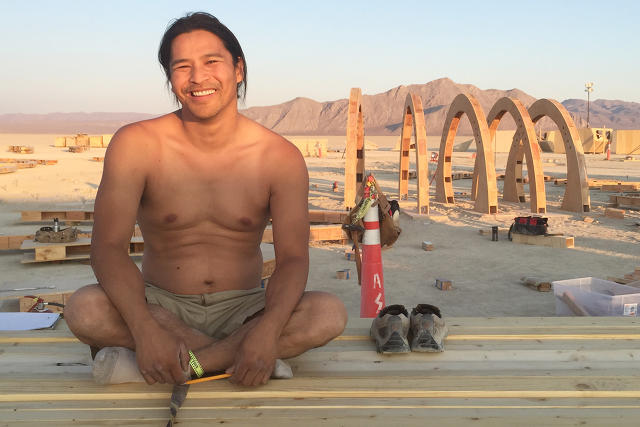
Taking Care Of Business
Numerous teams vied to be selected for the honor of building the Temple, and each had to expend significant effort putting together a proposal—including their engineering and fundraising plans.
Dreamers Guild designer Jazz Tigan first proposed his concept in 2013. Burning Man rejected his first attempt, but in March 2015—just five months before this year’s event—it notified Tigan and his team that they’d been selected to build the Temple.
As Jones recalls, that meant quickly figuring out how to do things like set up a business bank account—something that comes with more scrutiny than a personal account. “We told [the] banker we were making art and had received a grant,” Jones says. “We didn’t use the words ‘Burning Man’ because we didn’t know if they were friendly. We kind of had to do it under the guise of making a profit….We had to use the lingo of an LLC, not of a nonprofit. So we know the whole time that this is a $300,000 project and we’re going to burn it at the end, and we’re not going to make a profit. And we can’t tell her that.”
“We knew it wasn’t wise to be completely honest in the regular business world because it’s weird what we’re doing. We have a $300,000 product, and the whole thing will be purposefully destroyed.”
Though the team was not totally up front with bankers, Jones says the team was honest to insurance brokers about Temple of Promise’s intentions. At first, Temple of Promise struggled to find a company willing to insure the project but finally found a willing partner in The Hartford.
Burning Man doesn’t require the Temple be insured, but the team wasn’t taking any chances with their creation. About three weeks before Burning Man, Jones stood outside the Dreamers Guild’s main workshop, a cavernous space on a former Naval base in Alameda, California. She looked at a giant flatbed truck laden with most of the project’s materials. It was about to depart for Nevada. “Ninety percent of the Temple of Promise is on this truck,” Jones told me. “If this truck crashes, we’re fucked. This is quite literally the equivalent of putting all your eggs in one basket.”
The truck did make it to the desert safely. But not long before the whole crew arrived on the playa to begin final construction, Tigan and Jones received a letter from The Hartford. At first, the message was terrifying. It read, according to Jones, “We found out that you are building a 100-foot-high Temple. This is not acceptable under our small business insurance policies.” The policy was being unilaterally canceled.
But as Tigan read the letter, he broke out in laughter. The Temple will burn on September 6. The policy was being terminated effective September 15.
“We were on an installment policy for our payments,” Jones said, “and we hadn’t paid in full yet. So we win.”

Fundraising Troubles
Stop me if you’ve heard this before: An early-stage Silicon Valley team with a great idea struggles to raise money.
That was very much the Temple of Promise’s early story, as well. Despite a concept that many people loved, the team had a great deal of trouble pulling together the funds to complete the project. By mid-July, just a month-and-a-half before Burning Man, the Temple crew had raised only half the funds it needed—and they were verging on panic. As Jones told me at the time, she was worried that Burning Man itself would pull the plug on the project.
“David Best once said, ‘the Temple will not fail,’” Elizabeth Scarborough, Burning Man’s associate director of arts management, tells me. “‘When people struggle, the community needs and wants the Temple. It will not fail.’”
What Scarborough, known on the playa as Bettie June, meant is that no Temple project will be outright canceled. “It’s possible it may morph, and it may shift in size….[But] at the same time, the Temple, and what it means, it will not fail.”
Scarborough acknowledged that the Dreamers Guild had struggled more than almost any other past Temple project to raise the required money. In part, she suggested, this was because of “donor fatigue”—people with the resources to help out on large-scale Burning Man art had already given all they could, or wanted to.
“We looked at every angle to help them identify cost savings,” Scarborough said. “We helped them come up with different plans.” Practically speaking, that meant the Temple had to be reduced in height from 100 feet to about 70. And the team had to dispense with Tigan’s desire to clad much of the Temple in copper.
In the end, they pulled a rabbit out of a hat. All told, two Indiegogo campaigns and a Kickstarter brought in $125,000, multiple fundraising parties earned them 10 grand, and a group of anonymous donors kicked in a series of $5,000 and $10,000 donations. One New York donor pushed them over the top just before Burning Man, “by the skin of our teeth,” Jones says.

People Power
On day three of the on-site playa Temple build, the crew was cutting corners. Literally.
With more than 100 team members living alongside the Temple worksite over the two weeks before Burning Man’s gates officially open, they needed to make a whole lot of shade. They had purchased huge pieces of former billboard material to build one of the largest shade structures Burning Man has ever seen. That required slicing out corners from the plastic material in order to fit it properly onto custom-made wooden frames.
It’s been an all-new experience for Tigan, the project’s designer, who has never worked on a Burning Man art project before. Nathan Altman, the build lead, is a Burning Man first-timer, a “newbie.”
“I think it’s badass [that Burning Man] took a chance on a first-timer,” Jones says. “It just shows that there’s not art elitism at Burning Man. If you have a brilliant idea or design, you can get the support. You don’t have to have an art pedigree. People see it and say, ‘I want to build that,’ and that’s awesome.”
“I think that’s very true,” Scarborough says, adding that Burning Man gave grants this year to multiple inexperienced artists—including a team from London that had never been to the event. The organization helps these teams “step by step” with advice on engineering, rigging, materials, and heavy equipment.
Luckily for the Dreamers Guild, their team isn’t totally green; the team features veterans from most of the biggest Burning Man projects of the last few years. “That’s why the org was willing to take a chance on us,” Jones said. “We were a newly formed group of veterans coming together to support a first-time artist.”
For Tigan, seeing the energy the many volunteers put into the project has been eye-opening. “People said, ‘I love this. I can’t wait until you get this,’” Tigan says. “Then there were people who are like, ‘I can’t wait to help you get this.’ That little two-word difference is where dedication lives. They’re the ones who are going to be in the shop until 2 a.m.”
One of those people is Kelsey Owens, a veteran of major Burning Man projects like The Pier, The Pier 2, The Icthyosaur, and last year’s Embrace. Her experience brings a level of calm to the Temple crew, but she also recognizes the value of both old and new hands.
“It’s really conducive, a mix of people who’ve been here and people with fresh energy and ideas,” Owens says, “taking their expertise and real-world experience and applying it out here.”
Perhaps the most important thing she can teach, Owens added, is that compromise is necessary to finishing a huge art project.
“Like, the artist is never going to get [exactly] what they envisioned,” she said. “It’s material. It’s not the vision anymore. That can be demoralizing. [But] we’ve done it, and those compromises are worth getting to your final product so you can get it completed.”
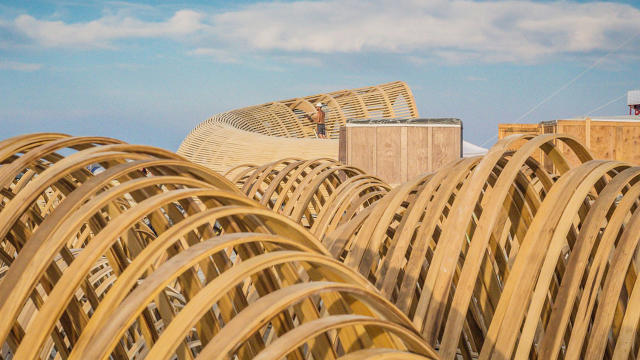
One of the unique elements about putting together an all-volunteer team for a huge project like The Temple of Promise is that you can never quite be certain that someone who steps up will be there all the way through. At the same time, you also find that people who volunteer for one task may in fact have far more valuable skills in another area.
For example, Nick McCracken showed up to the Alameda build site offering to help build shade structures. It turned out he was an expert electrician—and he ended up designing the Temple’s electrical grid.
Or take Altman, a longtime startup guy who has founded successful companies, and who most recently ran the Launch Festival, a huge showcase for startup tech companies. Altman wanted to help build the tree sculptures at the center of the Temple. But his organizational skills were better applied to the role of lead project manager. “I retooled the business,” Altman told me, “and put in processes to run finance and communication.”
Watching him work on the playa, you’d never know he was a newbie. As he ran morning meetings, he had the full attention and respect of the dozens of people following his lead. I asked him how this compared to other big projects he’s worked on over the years. “This is one of the more challenging,” Altman said, “if not the most challenging. It’s all volunteers.”
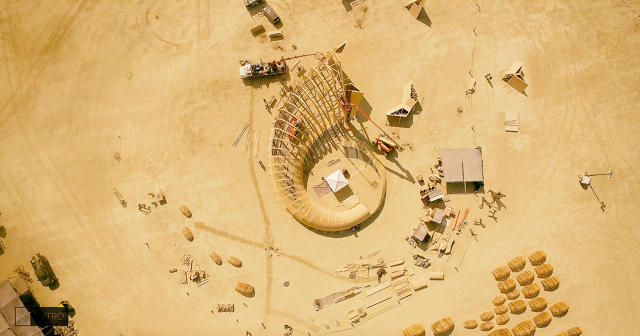
He also said he’d quickly come to realize that on a project where no one was being paid for their work, the true “currency” he had to offer was “giving people ownership, [and] finding the right people for the task.” Jones thinks that was without question the key to the success of the project. After all, she said, if you’d had to pay everyone who worked on the Temple, and for all the tools and machinery that were required, it would likely have been at least a $3 million effort.
What made it possible was the combined skills of everyone volunteering—top-tier professional Bay Area carpenters and engineers, electricians, architects, and so on. Not to mention those who donated computers, CNC machines, and other expensive equipment.
“Because we’re startup people with access to this technology,” Jones said, “that’s the only thing that made this possible.”
Fast Company , Read Full Story
(138)

